- News
- Science News
- Nasa's Hubble telescope's most iconic images of the cosmos
Nasa's Hubble telescope's most iconic images of the cosmos

A giant cluster of 3,000 stars
By utilizing near-infrared observations, the Hubble Space Telescope was able to penetrate the obscuring dust that enshrouds this stellar nursery. These observations provided astronomers with an unobstructed view of the nebula and the compact concentration of stars within the central cluster. (Photo: Nasa)

Giant red nebula and its smaller blue neighbor
NGC 2014 and NGC 2020, collectively known as the Cosmic Reef, are captured in this stunning image from the Hubble Space Telescope. The photograph reveals the immense influence of newly formed, massive stars on their surroundings.
The larger, red-hued nebula, NGC 2014, and its smaller, blue-colored companion, NGC 2020, belong to an expansive region of active star formation within the Large Magellanic Cloud. (Photo: Nasa)

M16 or the Pillars of Creation in visible light
The Hubble Space Telescope has once again captured the awe-inspiring "Pillars of Creation" within the Eagle Nebula, also known as M16. These colossal structures, composed of gas and dust, stretch for light-years into the cosmos. Hidden within their towering spires, new stars are being born, forever altering the celestial landscape.
The pillars first gained worldwide recognition after Hubble's initial image in 1995, taken using the Wide Field and Planetary Camera 2. (Photo: Nasa)

Butterfly Nebula combined of UV rays
NGC 6302, also known as the Butterfly Nebula or Caldwell 69, has been captured in a stunning image by the Hubble Space Telescope.
The image, which combines ultraviolet, visible, and infrared observations taken in 2019 and 2020, showcases the intricate details of this celestial wonder. (Photo: Nasa)

Sparkles with light from millions of newly formed young stars.
NGC 1569, also known as the Starburst Galaxy, is a remarkable celestial object that shines brilliantly with the radiance of countless newly born stars. This galaxy is experiencing an extraordinary period of star formation, producing new stars at an astonishing rate that surpasses our own Milky Way by a factor of 100. This prolific star-forming activity has been ongoing for nearly 100 million years, making NGC 1569 a fascinating subject for astronomical study. (Photo: Nasa)

Shreds of the colorful supernova remnant
In this captivating image captured by the Hubble Space Telescope, the remnants of a once-mighty star are displayed in a breathtaking array of colors and shapes. The supernova remnant, known as DEM L 190, is a testament to the violent demise of a massive star that once resided in the Large Magellanic Cloud, a diminutive satellite galaxy of our own Milky Way. (Photo: Nasa)

Young planetary nebula located about 8,000 light-years away
MyCn18, a nascent planetary nebula situated approximately 8,000 light-years from Earth, is depicted in this photograph captured by the Wide Field and Planetary Camera 2 (WFPC2) onboard the Hubble Space Telescope.
The image unveils the genuine form of MyCn18 as an hourglass, adorned with a complex array of "etchings" upon its walls. (Photo: Nasa)

Star about to explode, but no one knows when
Eta Carinae, a massive star, is on the brink of a potential cosmic catastrophe. Its enormous size, estimated to be around 100 solar masses, makes it a prime suspect for a spectacular supernova event. However, the exact timing of this stellar explosion remains uncertain, with predictions ranging from the immediate future to a million years from now. (Photo: Nasa)









